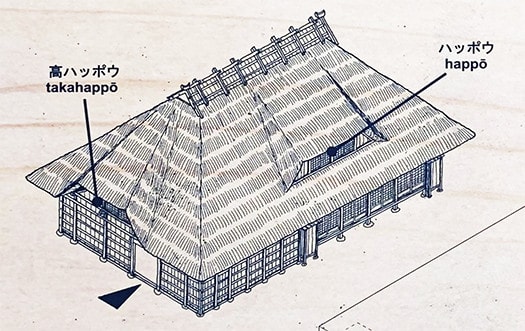


札幌も年間積雪量は6m近い豪雪地域。さらに人口の8割以上が集中する
日本の「温暖地域」が年平均気温がおおむね16度前後のなか、8度程度と寒冷気候。
そうであるのに、人口195万人(2015年調査)という世界寒冷地有数の大都市。
日本ではこういう積雪寒冷地に大都市を造営発展させるについて、
その居住環境の研究開発ということは明治以前まではまったくされなかった。
いや、戦前までほとんど実際的研究開発は進んでいなかったといえるだろうか。
明治の開拓が始まって、後に総理大臣にもなる薩摩閥の黒田清隆が
「洋造住宅」の旗振りを積極的に推進したことで、その端緒はできたけれど、
北米・北欧地域自体での研究開発もそこまで進んではいなかったので
手探りで遅々とした歩みが続けられていたと言えるのでしょう。
それが戦後になって、ブロック造三角屋根という地域自治体が積極推進する
工法開発努力の開始があって、一気に研究開発が加速した。
北米北欧でも同様に戦後大きく住宅性能進化が始まって、
呼応するカタチで、北海道では官民挙げた努力が本格化した。
そのような成果が札幌の人口急増という結果であったのかも知れません。
また、北海道が観光地としても人気が高いのは、
冬期家の外は寒いし多雪だけれど、家の中は温暖地以上に快適であることが、
体感的魅力としてアピールできていることも大きいと思える。
いま環境負荷軽減をさらに進めるために、また進化の社会的要請は高まっている。
一方で日本の古来からの民家住宅で積雪寒冷地の古民家も残っている。
この山形県の日本海側、出羽三山・湯殿山、月山の山麓地域の菅原家住宅は、
寒冷・多雪という気候条件では北海道と近似する地域性。
はるかな民族的近縁性を感じる。そこでどのような「対応」があったのか、
再検証するような思いでチェックしたいと思っています。
きのうは日本の江戸期古民家での調理・台所の様子を集中的に見ましたが、
本日は外観的な特徴、多雪地域対応としての「ハッポウ造」。
写真は妻側入口の2階部分に設けられたハッポウ造の様子。
〜妻側入口上部2階はセガイで持ち出し高ハッポウと呼ばれる開口部を設ける形が、
この家の外観の最も大きな特徴。この地方は有数の豪雪地帯で、高ハッポウは
積雪時の出入口としても利用したようである。また、屋根の平側にも
開口部(ハッポウと呼ぶ)を設け、小屋裏の採光と換気に役立てている。〜
という説明が川崎市教育委員会の解説にある。
セガイとは船枻造(せがいづくり)という手法で気仙大工がよく使う出桁の造り。
母屋に用いれば貫禄を高め、小屋に用いれば機能的空間が生まれる。
写真でもそのせり出しぶりはわかる。
積雪深が1階を越えて、2階からしか出入りできなくなることへの対応。
さらにこの地域では明治期に養蚕が盛んになったとされ、
そのための通気・換気・採光という意味合いから採用されたと推測されている。
ハッポウというコトバの意味合いはよくわからないけれど、
正面から見れば左右に八の字のように開いていることが感覚表現されたのか。
札幌も積雪深はそこそこだけれど、こういった工夫は存在しない。
もっと積雪深の深い岩見沢地域などでも、このような冬期専用開口は見られない。
想像では北海道の雪質は軽く、除雪がしやすい特徴があるので、
家の周りの積雪についてもそれを処理しやすいということがある。
一方で山形出羽三山周辺では雪質が重く、除排雪は困難ということのように思える。
2階からの出入りが建築的に造作され、1階でも外壁に頑丈そうな板が
張り回されて積雪対策としていることからも、雪質の重さが伝わってくる気がします。
English version⬇
[Snow country opening "Happo-zukuri" / Japanese good house ㉓-2]
Sapporo is also a heavy snowfall area with an annual snowfall of nearly 6m. Furthermore, more than 80% of the population is concentrated
Japan's "warm regions" have a cold climate of about 8 degrees Celsius, with an average annual temperature of about 16 degrees Celsius.
Even so, it is one of the largest cities in the world's cold regions with a population of 1.95 million (2015 survey).
In Japan, about building and developing a big city in such a snowy cold region
Research and development of the living environment was not done at all until before the Meiji era.
No, can we say that practical research and development had hardly progressed before the war?
Kuroda Kiyotaka, a Satsuma sect who later became Prime Minister after the development of the Meiji era began
By actively promoting the flag waving of "Western-style houses," the beginning was made, but
R & D in North America and Northern Europe itself has not progressed to that extent.
It can be said that the slow steps were continued by groping.
After the war, the local government called block-built triangular roof actively promoted it.
With the start of construction method development efforts, research and development accelerated at a stretch.
Similarly, in North America and Scandinavia, the evolution of housing performance began significantly after the war,
In response, the efforts of the public and private sectors have begun in earnest in Hokkaido.
Such a result may have been the result of the rapid increase in the population of Sapporo.
In addition, Hokkaido is also a popular tourist destination.
It's cold and snowy outside the house in winter, but the inside of the house is more comfortable than in warm climates.
I think that it is also great that it can be appealed as a sensational attraction.
Nowadays, social demands for evolution are increasing in order to further reduce the environmental load.
On the other hand, there are still some old Japanese houses in the snowy and cold regions.
The Sugawara family residence in the foothills of Mt. Dewa, Mt. Yudono, and Mt. Gassan on the Sea of Japan side of Yamagata Prefecture is
Regional characteristics similar to Hokkaido under the climatic conditions of cold and heavy snow.
I feel a far greater ethnic connection. What kind of "correspondence" was there?
I would like to check it with the feeling of re-verifying.
Yesterday, I focused on cooking and kitchen in an old folk house in the Edo period in Japan.
Today's exterior feature is "Happou-zukuri" for heavy snowfall areas.
The photo shows the Happou structure on the second floor of the entrance on the wife's side.
~ The upper 2nd floor of the entrance on the wife's side is taken out with a segai, and an opening called a high happou is provided.
This is the most distinctive feature of the exterior of this house. This region is one of the most heavy snowfall areas, and the high happo is
It seems that it was also used as a doorway during snowfall. Also on the flat side of the roof
An opening (called Happou) is provided to help with daylighting and ventilation of the back of the cabin. ~
The explanation is in the explanation of the Kawasaki City Board of Education.
Segai is a girder structure that is often used by Kesen carpenters in a construction method called ship making.
When used in a main building, it enhances dignity, and when used in a hut, a functional space is created.
You can see how it is protruding from the photo.
Correspondence that the snow depth exceeds the first floor and can only enter and exit from the second floor.
Furthermore, it is said that sericulture became popular in this area during the Meiji era.
It is presumed that it was adopted from the meaning of ventilation, ventilation, and daylighting for that purpose.
I don't really understand the meaning of Happou, but
Did it feel like it was open to the left and right like a figure eight when viewed from the front?
The snow depth is moderate in Sapporo, but there is no such device.
Even in the Iwamizawa area, where the snow depth is deeper, such winter openings cannot be seen.
Imagine that the snow quality in Hokkaido is light and it is easy to remove snow, so
Sometimes it's easier to handle the snow around the house.
On the other hand, the snow quality around Yamagata Dewasanzan is heavy, and it seems that it is difficult to remove snow.
The entrance and exit from the 2nd floor is architecturally designed, and even on the 1st floor there is a sturdy board on the outer wall
I feel that the weight of the snow quality is transmitted from the fact that it is stretched around to prevent snow accumulation.



















